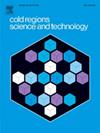A new freeze-thaw resistant superhydrophobic surface for cement-based materials with self-cleaning and anti/de-icing performance
IF 3.8
2区 工程技术
Q1 ENGINEERING, CIVIL
引用次数: 0
Abstract
Freeze-thaw (F-T) cycles can significantly deteriorate materials through water infiltration, pore water migration, ice-water phase transitions, and changes in pore structure. Traditional approaches primarily focus on modifying the internal pore structure to passively resist the F-T effects. In this study, we propose an active defense strategy based on wetting theory to enhance F-T resistance. We developed a new superhydrophobic surface tailored for the coarse and porous structure of cement mortar by employing polydimethylsiloxane (PDMS) as the primary film-forming substance and binder. Wetting-modified silica (SiO2) nanoparticles, treated with silane coupling agent KH570, were used to construct a micro-nano multilayer structure. To further enhance hydrophobicity, a reentrant porous micro-skeleton was formed through the phase separation of the PDMS mixture. By optimizing the chemical composition of the PDMS/KH570@SiO2 suspension, we achieved an exceptional superhydrophobic surface on the porous cement mortar. The performance of this surface was rigorously evaluated, including assessments of mechanical durability, self-cleaning behavior, anti-icing and de-icing properties, and F-T resistance. The results demonstrate that the new superhydrophobic surface delays the water droplet freezing time by approximately 23 times and improves the F-T resistance of cement mortar by at least 25 % compared to control samples. This study provides a novel approach for enhancing the durability of cement-based materials under F-T conditions in cold region engineering.
一种具有自清洁和抗除冰性能的新型水泥基材料抗冻融超疏水表面
冻融循环通过水的入渗、孔隙水的迁移、冰-水相变和孔隙结构的改变显著地恶化材料。传统的方法主要集中在改变内部孔隙结构来被动抵抗F-T效应。在本研究中,我们提出了一种基于润湿理论的主动防御策略来增强对F-T的抵抗力。以聚二甲基硅氧烷(PDMS)为主要成膜物质和粘结剂,开发了一种适合水泥砂浆粗糙多孔结构的新型超疏水表面。采用硅烷偶联剂KH570对润湿改性二氧化硅(SiO2)纳米颗粒进行处理,制备了微纳多层结构。为了进一步增强疏水性,通过PDMS混合物的相分离形成可重入的多孔微骨架。通过优化PDMS/KH570@SiO2悬浮液的化学成分,我们在多孔水泥砂浆上实现了特殊的超疏水表面。对该表面的性能进行了严格的评估,包括机械耐久性、自清洁性能、防冰和除冰性能以及抗F-T性能。结果表明,与对照样品相比,新型超疏水表面将水滴冻结时间延迟了约23倍,并使水泥砂浆的抗F-T性能提高了至少25%。该研究为寒区工程中提高水泥基材料在F-T条件下的耐久性提供了一种新的途径。
本文章由计算机程序翻译,如有差异,请以英文原文为准。
求助全文
约1分钟内获得全文
求助全文
来源期刊

Cold Regions Science and Technology
工程技术-地球科学综合
CiteScore
7.40
自引率
12.20%
发文量
209
审稿时长
4.9 months
期刊介绍:
Cold Regions Science and Technology is an international journal dealing with the science and technical problems of cold environments in both the polar regions and more temperate locations. It includes fundamental aspects of cryospheric sciences which have applications for cold regions problems as well as engineering topics which relate to the cryosphere.
Emphasis is given to applied science with broad coverage of the physical and mechanical aspects of ice (including glaciers and sea ice), snow and snow avalanches, ice-water systems, ice-bonded soils and permafrost.
Relevant aspects of Earth science, materials science, offshore and river ice engineering are also of primary interest. These include icing of ships and structures as well as trafficability in cold environments. Technological advances for cold regions in research, development, and engineering practice are relevant to the journal. Theoretical papers must include a detailed discussion of the potential application of the theory to address cold regions problems. The journal serves a wide range of specialists, providing a medium for interdisciplinary communication and a convenient source of reference.
 求助内容:
求助内容: 应助结果提醒方式:
应助结果提醒方式:


